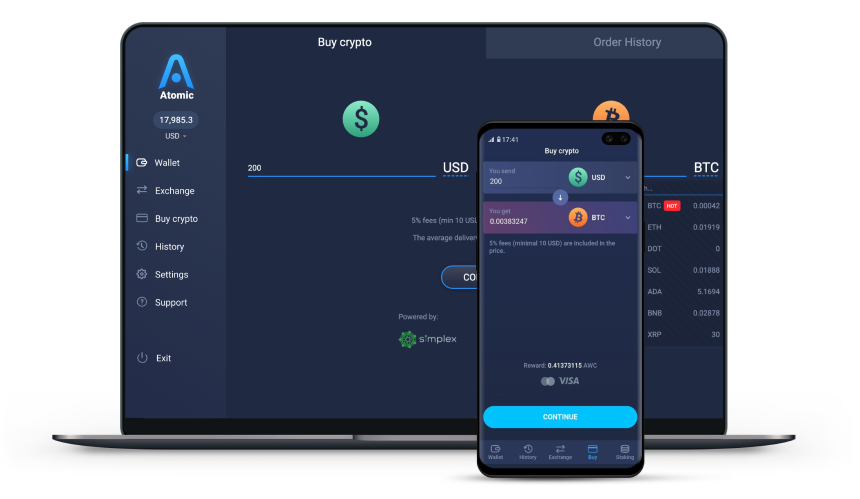Buy XRP (XRP) with Credit Card
Buy XRP with a debit or credit card, bank transfer, PayPal, Visa, or Apple Pay – fast and secure, straight into your app.




Buy XRP and 20+ Popular Coins in One Place
You can get Bitcoin, Ethereum, USDT, ADA and more than 20+ popular coins instantly with your card, worldwide.
Why Users Are Buying XRP Today
XRP is a fast, efficient cryptocurrency known for low transaction costs and high-speed international payments.

Fast and Reliable Transfers
XRP processes transactions in seconds, making it ideal for instant cross-border payments.

Low Transaction Fees
XRP offers extremely low fees, enabling cost-effective transfers even at high volumes.

Adoption and Use Cases
XRP is integrated into financial institutions and used globally for liquidity and transfers.
Payment methods

Buy XRP with Credit/Debit Card
Buy XRP instantly using your card. Atomic supports Visa, Mastercard, and more.

Buy XRP with Bank Transfer
Use SEPA or SWIFT to securely purchase XRP from your bank account.

Buy XRP with PayPal
Quick, secure XRP purchases with PayPal, no card entry needed.

Buy XRP with Google Pay
Android users can purchase XRP quickly with Google Pay on mobile.

Buy XRP with Apple Pay
For iOS users, Apple Pay enables fast XRP buying via Face ID/Touch ID.
What Our Customers Say
Jasmine Patel


Atomic made it easy to buy XRP without overcomplicating things. I used Google Pay, followed a few simple steps, and the coins arrived in minutes. Best experience I’ve had with a crypto app.
Leon Fischer


I’ve been using XRP for transfers, and Atomic Wallet is by far the fastest way I’ve found to get it. No account linking nightmares—just picked XRP, paid, done.
Maya Chen


Honestly, I didn’t trust crypto apps before. But Atomic felt different. Clean interface, no shady stuff, and I liked that I could see all the fees before confirming anything.


Get Even More Crypto
Use your card to buy more XRP or expand your portfolio – all in one app.
Buy crypto
FAQ
Got questions about buying XRP? Not sure where to buy XRP? Atomic Wallet gives you multiple ways to purchase it instantly. Here’s everything you need to know before getting started with our platform.
[email protected]What is the easiest way to buy XRP (XRP)?
The easiest way to buy XRP is through Atomic Wallet. Just install the app, complete a quick ID verification, choose XRP from the list, and pay using your preferred method. Your XRP will be delivered to your account in minutes – securely and hassle-free.
Can I buy XRP instantly with a credit or debit card?
Yes, Atomic Wallet lets you purchase XRP instantly using your credit or debit card. Visa, Mastercard, and other major providers are supported. It’s one of the fastest and most convenient ways to get started with XRP. Atomic supports major providers including Visa – allowing you to buy XRP with Visa effortlessly.
Is it safe to buy XRP online through Atomic Wallet?
Absolutely. All purchases are processed through trusted, licensed EU and US payment providers. Your transaction is encrypted, and your funds are sent directly to your wallet. No third-party custody, no compromises!
How long does it take to receive XRP after purchase?
Most XRP purchases are completed within 5 to 15 minutes. Processing time depends on your selected payment method, but in most cases, your XRP will arrive almost instantly.
Do I need a wallet to buy and store XRP?
Yes, and that’s why the Atomic Wallet is ideal. It automatically creates a secure, non-custodial wallet when you sign up. You retain full control of your XRP from the moment you buy it.
Can I get XRP with PayPal, Apple Pay, or Google Pay?
Yes, you can buy XRP with PayPal, depending on your region and selected provider. Just choose the method that works best for you at checkout. Apple Pay and Apple Cash are both supported, so you can buy XRP with Apple Cash right from your iPhone.
Are there any fees when buying XRP through Atomic Wallet?
Yes, third-party providers apply a small processing fee for handling transactions. All fees are shown clearly before confirmation – there are no hidden charges, and you always know what you’ll pay.
What can I do with XRP after buying it?
You can hold XRP, use it for payments, or swap it for over 20 other coins directly from Atomic Wallet.













